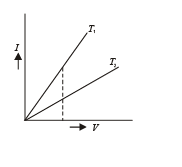JEE Advanced (Fill in the Blanks): Current Electricity | Chapter-wise Tests for JEE Main & Advanced PDF Download
Q.1. An electric bulb rated for 500 watts at 100 volts is used in a circuit having a 200 volts supply. The resistance R that must be put in series with the bulb, so that the bulb delivers 500 watt is ..........ohm.
Ans. 20
Solution. We know that 


NOTE : For the bulb to deliver 500 W, it should have a p.d. of 100 V across it. This would be possible only when R = 20 Ω is in series with the bulb because in that case both resistances will share equal p.d.
Q.2. The equivalent resistance between points A and B of the circuit given below is ......Ω .

Ans. R/2
Solution. The given circuit may be redrawn as shown in the figure.
Thus, the resistances 2R, 2R and R are in parallel.
Hence, 


Q.3. In the circuit shown below, each battery is 5V and has an internal resistance of 0.2 ohm.

The reading in the ideal voltmeter V is ..... V.
Ans. 0
Solution. Let a current I flow through the circuit. Net emf of the circuit = 8 (5V) = 40 V
Net resistance in the circuit = 8 (0.2 Ω) = 1.6 Ω Current flowing through the circuit,

The voltmeter reading would be V = E – IR = (5V) – (25A) (0.2 Ω)
= 5V – 5V = 0
True/ False
Q.1. In an electrolytic solution the electric current is mainly due to the movement of free electrons.
Ans. F
Solution. NOTE : An electrolyte solution is formed by mixing an electrolyte in a solvent. The electrolyte on dissolution furnishes ions. The preferred movement of ions under the influence of electric field is responsible for electric current.
Q.2. Electrons in a conductor have no motion in the absence of a potential difference across it.
Ans. f
Solution. NOTE : Billions of electrons in a conductor are free and have thermal velocities. The electrons have motion in random directions even in the absence of potential difference.
Q.3. The current –voltage graph s for a given metallic wire at two different temperatures T1 and T2 are shown in the figure.

The temperature T2 is greater than T1.
Ans. T
Solution. For a given voltage, current is more in case of T1.
Since, V = IR


Resistance is less in case of T1 and more in T2.
NOTE : For a metallic wire, resistance increases with temperature, therefore T2 > T1
|
481 docs|964 tests
|





















